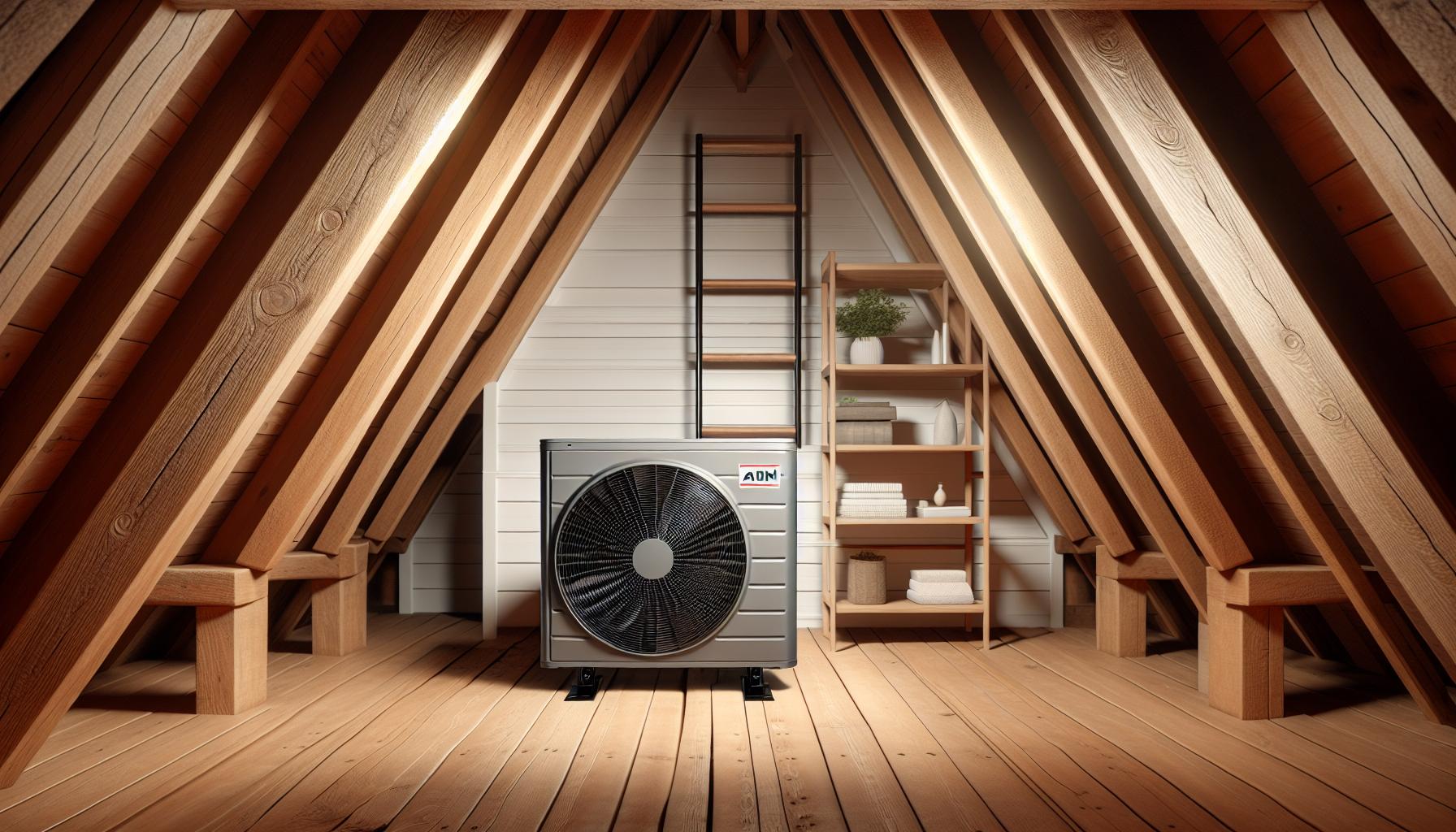Imagine transforming your attic into a comfortable, climate-controlled space without the hassle of extensive ductwork. That’s where the mini split attic air handler comes in. This innovative solution offers a seamless way to manage temperatures in your attic, making it an ideal choice for homeowners looking to maximise their living space.
In this text, you’ll discover why mini split systems are gaining popularity, particularly for attic installations. We’ll explore their efficiency, ease of installation, and the long-term benefits they bring. Whether you’re considering a home office, guest room, or simply better storage conditions, understanding the advantages of a mini split attic air handler is crucial.
Stay with us as we investigate into the specifics of how these systems work, the installation process, and the key factors to consider when choosing the right unit for your home. By the end, you’ll have a clear picture of why this could be the perfect solution for your attic needs.
What Is A Mini Split Attic Air Handler?
A mini split attic air handler is a key component of a mini split heating and cooling system, designed specifically for attic installations. Unlike traditional HVAC systems, mini splits don’t need ductwork, making them ideal for attics where space and accessibility are limited. These systems consist of an outdoor compressor and an indoor air handling unit. The attic air handler circulates conditioned air throughout your attic space, maintaining a comfortable environment regardless of external temperatures.
Mini split systems offer flexible installation options. Wall-mounted units are common but may not suit attics with vaulted ceilings or limited wall space. Floor-mounted units provide an alternative, sitting at the bottom of walls and fitting neatly into unique attic layouts. This flexibility ensures you can efficiently heat or cool your attic without extensive modifications.
Advantages Of A Mini Split Attic Air Handler

Mini split attic air handlers offer several benefits, making them an attractive option for climate control in attic spaces. This section highlights key advantages, focusing on energy efficiency, zoning capabilities, and easy installation.
Energy Efficiency
Mini split systems are highly efficient, avoiding the energy losses typical of ducted systems. Inverter technology in many units maintains a steady temperature, reducing overall energy consumption and wear.
Zoning Capabilities
Mini splits offer individual room control, enabling you to set different temperatures in different areas. This zoning capability leads to significant energy savings by not heating or cooling unoccupied spaces.
Easy Installation
Installing a mini split system in your attic is straightforward, as it doesn’t require extensive ductwork. These systems come with flexible installation options, including wall-mounted and floor-mounted units for various attic layouts.
Key Features To Consider
When choosing a mini split attic air handler, several key features can impact performance and comfort. Here are essential aspects to evaluate:
Capacity
The capacity of a mini split air handler must match the space’s heating and cooling needs. For example, a 1,200 sq ft second floor might need around 18,000 BTU for cooling, as determined by a Manual J calculation. Oversizing can cause inefficiency and higher costs, so ensure precise sizing to avoid energy waste.
Noise Levels
Noise levels are critical, especially if the unit sits near bedrooms or living areas. Placing the air handler in an attic or insulated closet reduces noise in occupied spaces. Noise mitigation strategies, such as additional insulation, can further decrease disturbances, ensuring a quieter environment.
Thermostat Compatibility
Thermostat compatibility ensures you can control the mini split air handler with ease. Modern mini splits often work with smart thermostats, allowing remote adjustments and integration with home automation systems. Check for compatibility with popular models to enhance convenience and efficiency.
Installation Process
Installing a mini split attic air handler involves several crucial steps to ensure optimal performance and efficiency. Follow these guidelines for a successful installation.
Pre-Installation Requirements
- Size Calculation:
Determine the correct size of the mini split system. An undersized system won’t keep up, and an oversized system will cycle on and off too frequently, reducing efficiency. - Location Selection:
Choose a location for the outdoor unit that is out of direct sunlight and away from areas where snow or ice can accumulate. Ensure it is easily accessible for maintenance. For the indoor air handler, select a location high on the wall or ceiling, away from sources of heat or cold, and ensure it is easily accessible for cleaning and maintenance. - Electrical Considerations:
Ensure you have the necessary electrical infrastructure. Many mini splits require a dedicated 220-volt circuit on its own breaker. Smaller units may only require 110 volts.
Step-by-Step Guide
- Mount the Indoor Unit:
Secure the mounting plate on the chosen wall or ceiling location. Attach the indoor unit to the plate, ensuring it is level. - Install the Outdoor Unit:
Position the outdoor unit on a flat surface, ideally on a concrete pad or a wall bracket. Ensure it is level and has adequate clearance on all sides. - Connect the Refrigerant Lines:
Run the refrigerant lines between the indoor and outdoor units. Ensure the connections are tight and sealed to prevent leaks. - Electrical Wiring:
Connect the electrical wires between the units. Ensure all connections are secure and meet local electrical codes. - Test the System:
Once all connections are made, test the system to ensure it operates correctly. Check for any leaks or issues and address them promptly.
- Insulation:
Ensure the attic is properly insulated to maximise the efficiency of the mini split system. - Maintenance:
Regularly clean the filters and coils of the indoor unit to maintain optimal performance. - Professional Assistance:
If unsure about any step, consult a professional installer to avoid potential issues and ensure a safe and effective installation.
Maintenance Tips
Maintaining your mini split attic air handler is crucial for its performance and longevity. Regular cleaning and seasonal checks ensure your system runs efficiently and reliably.
Regular Cleaning
- Air Filters: Replace air filters every 4-6 weeks to maintain air quality and system performance. Dust and allergens can compromise efficiency.
- Condenser Coils: Clean condenser coils every 4-6 weeks. Turn off the power, wait an hour, and use a soft, dry cloth to wipe down the coils.
- Drainage: Ensure the condensate drain is clear and functional. Clean the drain hose annually to prevent water backup and damage.
- Blower Wheel: Clean the blower wheel regularly. Use a mini split bib kit or a 5-gallon bucket with a pump sprayer and warm water.
- Inspection: Conduct regular inspections of your mini split system to spot potential issues early. This prevents minor problems from becoming major ones.
- Performance: Check system performance at the start of each season. This ensures your mini split is ready to handle temperature changes efficiently.
Conclusion
Opting for a mini split attic air handler can transform your attic into a comfortable, climate-controlled space without the hassle of extensive ductwork. These systems offer exceptional energy efficiency and flexibility, making them an ideal choice for attics with limited space. With their simple installation process and zoning capabilities, mini splits allow you to enjoy precise temperature control and substantial energy savings.
When selecting a unit, consider factors like capacity, noise levels, and compatibility with smart thermostats to ensure you get the best performance for your needs. Regular maintenance is crucial to keep your system running efficiently and extend its lifespan. By following these guidelines and seeking professional help when needed, you’ll achieve a safe and effective setup that enhances your home’s comfort and value.
